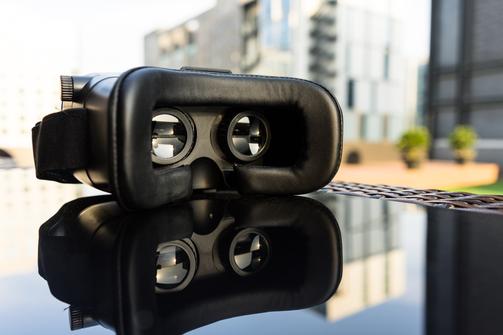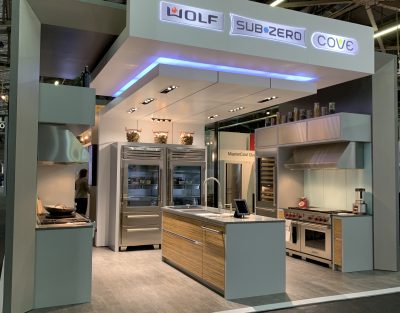When it comes to incorporating technology into your exhibit, it’s easy to get carried away. There’s so much to choose from, and it’s all so shiny. But every element of technology in your exhibit should have a purpose. And it should never distract from your story. Here are a few things to think about when choosing technology for your exhibit.
Technology should have a business purpose.
Think about technology as a doorway to your brand story, and ultimately a sale. As such, technology should serve as a link between people, information and experiences. Most importantly, it should tie directly to your business purposes. But if you use technology simply to attract visitors to your exhibit, be aware that although people may remember it, they might not remember you or your story.

A video playing on an embedded large flatscreen monitor dramatically portrays the features and benefits of Sleep Number’s newest products better than static graphics ever could. Additionally, the color-changing triangles on the ceiling directly link the Sleep Number logo to the new temperature-changing Climate 360 Smart Bed.
Technology should illuminate the value of what you provide in a way that nothing else can.
When determining if a certain type of technology makes sense for your exhibit, this should be your litmus test. In the B2C world, we often see this take the form of, say, selfies in the context of products. Sure, this is memorable and shareable, but these personal, visceral types of engagement may not be as attractive for B2B buyers. These folks are on a business mission—and are answering to others for their time. But this doesn’t mean the B2B world is adverse to selfies or any type of technology in particular. You should certainly go for an on-the-edge technology like 3D printing, augmented reality or virtual reality—but only if it passes the litmus test.
This Cove video wall uniquely highlights the product features by providing an immersive experience inside of the dishwasher, mimicking the various dishwasher cycles.
Technology should be easy for your visitors and booth staffers to use.
Here’s a big clue you have chosen tech-for-tech-sake, rather than choosing tech to uniquely tell your story: your booth staff and attendees waste far too much time explaining or figuring out how to use it. That’s technology that gets in the way, instead of illuminating your brand. You want your attendees to walk up and start absorbing or interacting with your messages effortlessly. And you want your staffers to avoid being so frustrated by your intimidating technology that they end up presenting a negative vibe to visiting prospects.

Delta utilized technology that featured a custom, interactive program allowing attendees to effortlessly navigate through the features of their new Voice IQ technology.
Technology should maintain or improve your trade show return on investment.
If the technology you add increases your overall exhibiting costs, you need a commensurate increase in leads and sales to maintain your program’s return on investment. The good news: that’s very doable. Well-designed digital content presented using the right technology will attract more visitors into your booth. Additionally, with technology’s inherent interactivity and personalization, your booth staff can tailor their visual presentation to each visitor. The resulting improved engagement will very likely increase your lead counts and sales pipeline. You can also minimize technology costs by strategically renting or buying your booth tech depending on how many times you will use it, by reducing your graphics costs by changing messages on flatscreens rather than graphics, and by splitting your costs with other cost centers when you plan to use your digital content and technology beyond the trade show.

This flatscreen monitor was strategically placed to show live cooking demos to a broad audience and to highlight product features and benefits between demos.
Technology should bring prospects closer to the sale.
Above all else, the technology in your exhibit should feel like a natural extension of your story; it should never steer prospects off course. It should be another tool that fortifies your sales process—and it should ultimately compel prospects to engage and take action.
Give us a call. We can help you find the right technology, so you can stick to your story.




